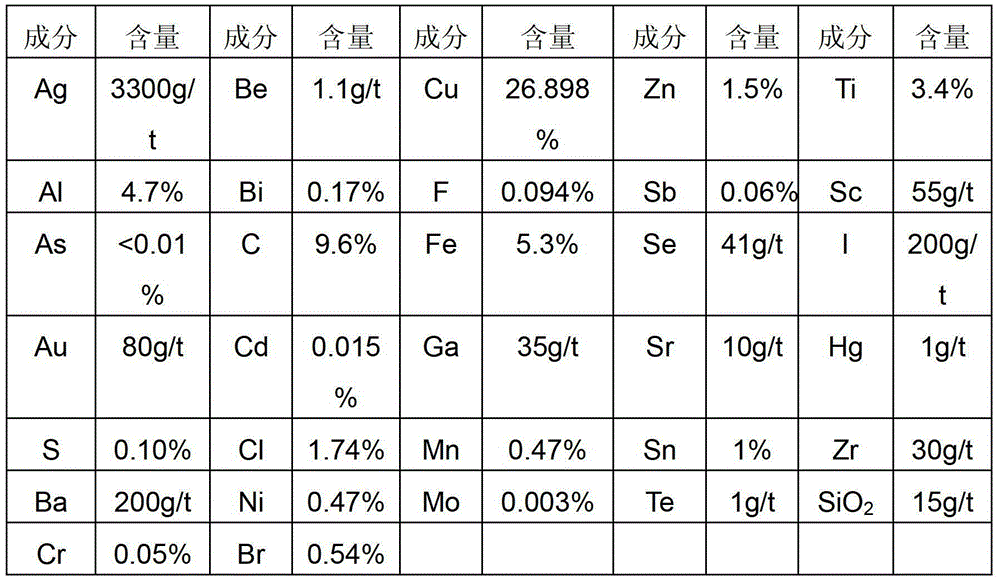Method for processing waste circuit board
A technology of waste circuit boards and treatment methods, which is applied in the field of waste circuit boards, can solve the problems of complex equipment, low metal recovery rate, and low purity, and achieve the effects of high recovery rate, high purity, and simple processing equipment
- Summary
- Abstract
- Description
- Claims
- Application Information
AI Technical Summary
Problems solved by technology
Method used
Image
Examples
Embodiment 1
[0033] A processing method for processing waste circuit boards, the steps are as follows:
[0034] Plastic carbonization. The waste circuit board is heated to 600°C in a heating furnace, and the atmosphere in the heating furnace is an inert atmosphere of carbon dioxide. Burn time 2 hours.
[0035] Ball milling separates plastics and metals. Put the burnt circuit board into a ball mill for ball milling, the ratio of ball to material is 1:1, and the ball milling time is 2 hours. The material after ball milling is separated from plastic powder and metal by sieving machine. The plastic content in metal has been reduced from 30% to 2.5%.
[0036] Alkali roasting. The metal after the separation of plastics is mixed with NaOH and then roasted with alkali in a rotary kiln. The roasting temperature is 400°C and the roasting time is 2 hours. The amount of alkali added is 1.4 times the amount of tin, antimony and lead in the metal. The calcined material is ground and then soaked in...
Embodiment 2
[0041] A processing method for processing waste circuit boards, the steps are as follows:
[0042]Plastic carbonization. The waste circuit board was heated to 550° C. in a heating furnace, and the atmosphere in the heating furnace was nitrogen inert atmosphere. Burn time 2 hours.
[0043] Ball milling separates plastics and metals. Put the burnt circuit board into a ball mill for ball milling, the ball-to-material ratio is 1:2, and the ball milling time is 3 hours. The material after ball milling is separated from plastic powder and metal by sieving machine. The plastic content in metal has been reduced from 30% to 1.5%.
[0044] Alkali roasting. The metal after the plastic separation is mixed with NaOH and then roasted with alkali in a rotary kiln. The roasting temperature is 350°C and the roasting time is 2 hours. The amount of alkali added is 1.5 times the amount of tin, antimony and lead in the metal. The calcined material is ground and then soaked in water at a temp...
Embodiment 3
[0049] A processing method for processing waste circuit boards, the steps are as follows:
[0050] Plastic carbonization. The waste circuit board is heated to 600° C. in a heating furnace, and the atmosphere in the heating furnace is a vacuum atmosphere. Burn time 3 hours.
[0051] Ball milling separates plastics and metals. Put the burnt circuit board into a ball mill for ball milling, the ball-to-material ratio is 1:2, and the ball milling time is 3 hours. The material after ball milling is separated from plastic powder and metal by sieving machine. Plastic content in metal reduced from 30% to 3%.
[0052] Alkali roasting. The metal after the plastic separation is mixed with NaOH and then roasted with alkali in a rotary kiln. The roasting temperature is 450°C and the roasting time is 2 hours. The amount of alkali added is 1.5 times the amount of tin, antimony and lead in the metal. The calcined material is ground and then soaked in water at a temperature of 90° C. and ...
PUM
 Login to View More
Login to View More Abstract
Description
Claims
Application Information
 Login to View More
Login to View More - R&D
- Intellectual Property
- Life Sciences
- Materials
- Tech Scout
- Unparalleled Data Quality
- Higher Quality Content
- 60% Fewer Hallucinations
Browse by: Latest US Patents, China's latest patents, Technical Efficacy Thesaurus, Application Domain, Technology Topic, Popular Technical Reports.
© 2025 PatSnap. All rights reserved.Legal|Privacy policy|Modern Slavery Act Transparency Statement|Sitemap|About US| Contact US: help@patsnap.com

